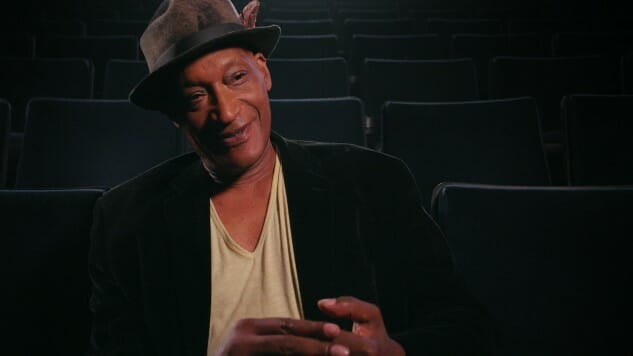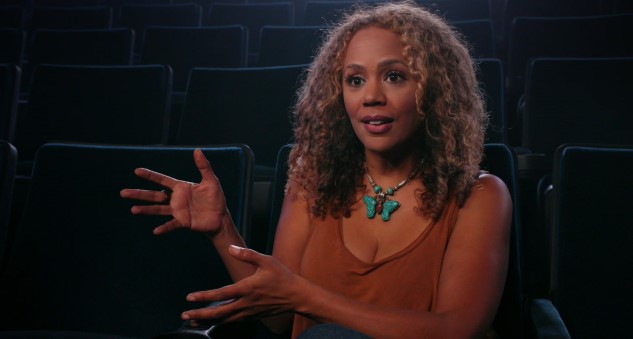Shudder’s Horror Noire Is a Loving Tribute and Revealing Critique of the History of Black Horror
Photos via Shudder Movies Features horror movies
In the opening preamble of Shudder’s new documentary Horror Noire, professor Robin R. Means Coleman lays out a simple but effective mission statement when it comes to assessing the history of African Americans in the past century of horror cinema: “Black history is black horror.”
Brutally honest, perhaps, but equally incisive. Horror Noire is a documentary about a community of often ostracized and maligned people coming to terms with their fondness for a genre that has rarely treated them well. Director Xavier Burgin has made what is for the most part a talking heads documentary, primarily structured around actors, writers and directors ruminating on the horror genre from the confines of a darkened theater. It comes to viewers in the guise of a history lesson, but simultaneously manages to provoke some palpable cognitive dissonance from its subjects and would-be teachers, who often find themselves grappling with the enjoyment they feel as audience members vs. the weight of responsibility they feel as black educators or activists—the compulsion to always be striving to combat inequality. Author Tananarive Due puts it best in the film’s opening moments: “We’ve always loved horror. It’s just that horror, unfortunately, hasn’t always loved us.”
Of course it’s not just the horror genre that hasn’t always been helpful in its depiction of black Americans. From the beginning of the motion picture industry, black Americans were most often completely unrepresented, and when they were present, it was in the form of broad racial caricature. As Due observes, watching clips of dancing and cavorting black men from 1915’s now-infamous The Birth of a Nation, that film’s depiction of laziness, squalor and slovenly behavior “reigned as the picture of black life for so many years,” before black actors began to be cast in the most basic of roles. Decades of comic relief, silent servants or “savage” jungle tribesmen followed.
In the horror genre, meanwhile, the specter of Black America often filled in for the “monster” of films, sometimes in a literal sense, but more often obliquely. Exaggerated features of monsters called to memory earlier newspaper caricatures of laborers or slaves, while films such as King Kong drew such close parallels to the black experience in America that Tarantino was still calling attention to it decades later via Inglorious Basterds. Not until the early 1970s did films starring black actors in leading roles emerge as a legitimate money-making endeavor in Hollywood.
This era, that of the “blaxploitation” genre, receives some interesting coverage in Horror Noire. It’s fascinating to watch actors such as Tony Todd (Candyman), Ken Foree (Dawn of the Dead) and Keith David (The Thing) grapple with the enjoyment they clearly felt as young men watching movies such as Super Fly, Coffy or Abby, cooled to some degree by the perspective and distance of age. At the time, you can hardly blame black audience members for being excited in seeing themselves up on the big screen—and not just there, but as badass protagonists fighting to “clean up the streets” or take down white overlords. And yet, the outlandish stereotypes the genre tended to revel in arguably had their own negative effects—so says Keith David at one point, recalling an instance where a white man saw him in a new hat and saluted him with “Hey, pimp!”, seemingly thinking he was paying David a compliment. It makes sense that enthusiasm eventually gave way to a more mature rejection of these types of stories, as sought by the NAACP’s Coalition Against Blaxploitation.
 Keith David confers with Dawn of the Dead’s Ken Foree.
Keith David confers with Dawn of the Dead’s Ken Foree.
Ultimately, for the enthusiastic horror geeks in the house, Horror Noire may feel a little bit familiar, filled with tidbits and factoids they’ve repeatedly heard in other sources over the years—such as the fact that the lead role of Night of the Living Dead wasn’t originally written as either black or white, or the fact that Jordan Peele’s Get Out was originally intended to end with its black protagonist being taken to jail. But even the seasoned horror fan will probably learn a few things along the way, whether it’s Keith David’s secret high school desire to be “the first black Dracula,” or the admittedly hilarious original title of Blacula, which was apparently Count Brown Is in Town. Numerous tropes receive detailed discussions as well, whether it’s the “black character dies first” cliche of ’80s slasher movies, or the more modern “Sacrificial Negro,” who willingly puts himself in harm’s way just so the film’s white folks have a chance to live and thrive.
During its more personal moments, though, the film justifies its existence beyond functioning as a rote history. Actress Rachel True, who appeared as a black high school witch in ’90s cult classic The Craft, is especially affecting as she divulges the pain and frustration of feeling like your talents are forever being overlooked because of the color of your skin. She watches modern films such as The Girl with All the Gifts (which stars young black actress Sennia Nanua) with both joy and ruefulness in her heart, admitting that she finds herself wishing such roles had been available to her when she was younger. Instead, she says, she spent the best acting years of her life asking some variation of “Are you OK?” to young white women, in a slew of roles as “best friends.” And lest we forget, True recently had to mobilize the power of internet activism and outrage just to get invited to a The Craft reunion—a reunion that had already booked all of her white co-stars, while ignoring her.
 True shares some of the film’s most personally affecting material.
True shares some of the film’s most personally affecting material.
Horror Noire is a reminder that despite whatever sense of progress we assume is being made, it’s always easy for society (and Hollywood norms) to backslide if we allow them to do so. The successes of films such as Peele’s Get Out are easy to appreciate in hindsight, but for Peele to be able to make that film at all (and do it his way) was by no means something that was guaranteed. As the director says in his interview—which he gives sitting in the leather chair that his character was tied to in Get Out’s third act—he knew that Get Out would represent a make-or-break moment for his career. If the film had failed, or if Peele hadn’t been able to convince producers of the sanctity of his vision, he certainly wouldn’t be attached to half a dozen high-profile projects right now.
“When I found out they were going to let me actually direct Get Out, I knew something big was going to happen,” he says. “I thought there was a chance something very bad could happen; that I would get run out of town, you know. I thought there’s a possibility people don’t want to see entertainment about something that has traditionally been dealt with, with a certain reverence. But I also thought this was the movie I wanted to see.”
Peele, thankfully, was able to make the movie he wanted to see; the movie he wanted to make. With that in mind, Horror Noire unsurprisingly ends on a hopeful note, as footage of Peele’s upcoming Us spools out and the film’s assembled talking heads gaze forward toward an egalitarian genre movie future that has been more than a century in the making. There will surely be more bumps in the road before any kind of true parity is achieved, but it genuinely does feel like a moment for optimism. The name might be noire, but the future seems pretty bright.
Horror Noire is streaming on Shudder now.
Jim Vorel is a Paste staff writer and resident horror geek. You can follow him on Twitter for more film writing.